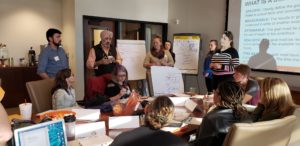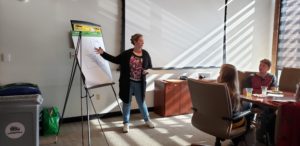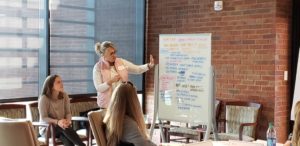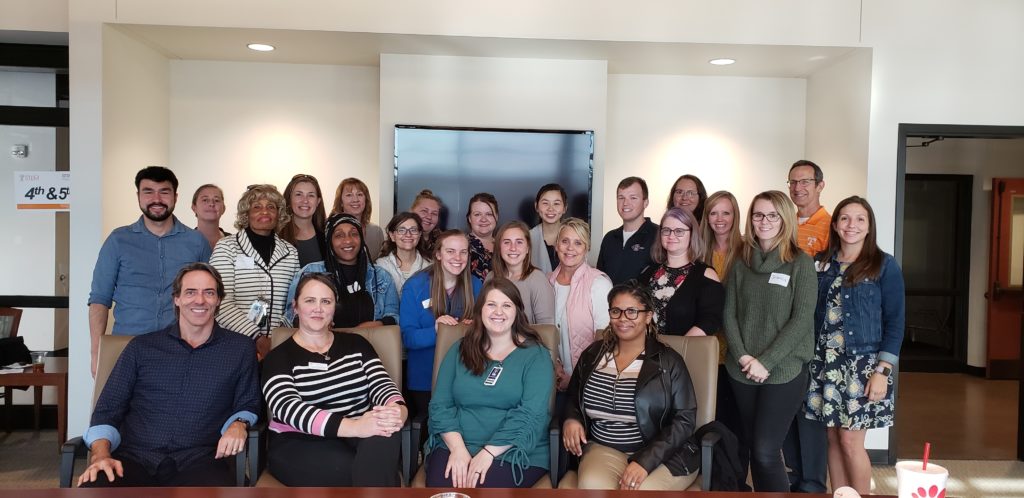ISE hosts Knox County STEM District-Learning Days
As part of the Industrial and Systems Engineering Department (ISE) Outreach and Engagement (OnE) team efforts, and in support of our Knox County Schools (KCS), two district learning day programs were hosted for K-5 and middle school STEM educators and support personnel. These endeavors were the first collaborations between the ISE and the KCS STEM organization, in conjunction with the Tickle College of Engineering (TCE), the East Tennessee STEM Hub and Center for Educators of Engineering, Math, and Science (CEEMS), the Big Orange Steam Symposium (BOSS), and the Office of Research and Engagement (ORE) as program partners, but they will not be the last!
The uniqueness of these events began with the makeup of the developers and attendees. Involved in the planning were not only key ISE and KCS STEM representatives, but also contributors from the College of Education and Human Services – represented by the East Tennessee STEM Hub/CEEMS, the Coordinator of Community Learning Services and Diversity Programs from the Hodges Library, visiting Brazilian Industrial Engineering scholars, the Director of the UT Graduate Engineering Education Certificate Program, the Pre-College Research Excellence Programs from the Officer of Research & Engagement, and the TCE Associate Dean for Academic and Student Affairs. All of these groups participated in each days’ outcomes, in addition to our own ISE faculty and students. Enthusiasm and eagerness for learning and a shared, new venture were displayed in all of the participants.
The elementary event was held in November of 2019. It began with the introduction of all present, and background from key individuals, expounding on the commitment and resources available. Speakers were Mallory Sterling, KCS STEM Facilitator; John Kobza, Department Head ; Dr. Ozlem Kilic, Associate Dean for Academic and Student Affairs; Nick Kim, ETN STEM Hub, UT Math Education; and Courtney Faber, lecturer and research assistant professor.
Kilic specifically emphasized the university and TCE’s commitment to engagement and community support, and illustrated all the college resources to provide this support. She shared her personal story in coming to America for higher education, and how it motivated her to see a path for TCE to enhance our global engagement across the campus and the world, beginning with our recruitment and readiness efforts.
After the valuable discussions, the working part of the event convened. ISE representatives, led by Laura O’Shaughnessy, Assistant Professor of Practice and ISE OnE Coordinator, and Ashley Chen, ISE Senior and OnE ambassador, engaged those present, in a plan of attack using the Engineering Design Process and industrial engineering tools, to develop their teaching methods.
representatives, led by Laura O’Shaughnessy, Assistant Professor of Practice and ISE OnE Coordinator, and Ashley Chen, ISE Senior and OnE ambassador, engaged those present, in a plan of attack using the Engineering Design Process and industrial engineering tools, to develop their teaching methods.
The group of 26 was divided into two groups, consisting of KCS educators, UT faculty, and UT ISE and engineering education/service learning students. Each was presented with a current community issue. The groups then applied the five step engineering design process utilized in Knox County to ask, imagine, plan, create, and improve the different facets of their assigned issue in order to solve the specific, real-world problem. This exercise not only showed the true colors of an ISE, the domains we address, and the systems we improve, but challenged the teachers to think like one through role-playing, in which the teachers assumed the role of their students.
The principles of industrial engineering address many opportunities and issues which may not seem like engineering concerns, using technical, engineering, and methodical tools to create real solutions, then implement them successfully, and ensure lasting gains. We cover a variety of different domains concerning other engineering/ business disciplines to look at  systems, impact, interactions, design, and improvement. The educators and faculty present were able to experience these roles and the EDP first-hand, then take-away ideas to bring into their own classrooms, as well as the tools necessary to apply the EDP in a K-5 environment. Some of the feedback reflected that teachers would be able to utilize their new skills immediately in their classrooms, and this learning opportunity opened their eyes to think outside the box, apply new tools, and see through the eyes of their students, making them more motivated and effective teachers.
systems, impact, interactions, design, and improvement. The educators and faculty present were able to experience these roles and the EDP first-hand, then take-away ideas to bring into their own classrooms, as well as the tools necessary to apply the EDP in a K-5 environment. Some of the feedback reflected that teachers would be able to utilize their new skills immediately in their classrooms, and this learning opportunity opened their eyes to think outside the box, apply new tools, and see through the eyes of their students, making them more motivated and effective teachers.
KCS educators and others present were also granted the opportunity to visit the VEX YNot Team Practice Space, hosted by Grant Kobes, ISE student and VEX YNot Team founder. The visit was of great interest to most attendees, who coach or host VEX Robotics teams at their own school. Several educators (and alumni!) stayed past regular working and in-service day requirements to tour the Tickle College of Engineering on a private tour TCE from our one of our own ISE students and TCE ambassador, Cody Ramangkoun.
The February 2020 event began with a breakfast resource fair in the atrium of the John D. Tickle Engineering Building. Participants from KCS middle school grades took the opportunity to browse and learn about campus connections for themselves and to share with students.
 The hands-on learning process for that day was conducted in a similar fashion to the earlier event, but the model was directed to the middle school appropriate engineering design process steps. Sixteen KCS teachers, faculty, and engineering students collaborated to solve community problems, while building relationships amongst the teachers who are daily separated by their different schools. Rupy Sawhney, Health Fellow in Business and Engineering, Rachel Ware, ISE OnE ambassador, Lauren Lingar and Jacob McPherson, ISE department ambassadors, and graduate students Lorna Treffert, Joel Thomas, Chulin Chen, and Guilherme Zuccolotto assisted with the day’s learning.
The hands-on learning process for that day was conducted in a similar fashion to the earlier event, but the model was directed to the middle school appropriate engineering design process steps. Sixteen KCS teachers, faculty, and engineering students collaborated to solve community problems, while building relationships amongst the teachers who are daily separated by their different schools. Rupy Sawhney, Health Fellow in Business and Engineering, Rachel Ware, ISE OnE ambassador, Lauren Lingar and Jacob McPherson, ISE department ambassadors, and graduate students Lorna Treffert, Joel Thomas, Chulin Chen, and Guilherme Zuccolotto assisted with the day’s learning.
Following problem-solving, the group shared new methods and tools learned during the event, and brainstormed ways in which the STEM teachers could take these tools back to their classrooms for immediate application. Each teacher left with a sense of connection to their colleagues and several new, ready-to-use tools for their teaching ‘toolbox’.
the event, and brainstormed ways in which the STEM teachers could take these tools back to their classrooms for immediate application. Each teacher left with a sense of connection to their colleagues and several new, ready-to-use tools for their teaching ‘toolbox’.
In the end, all attendees participated in an almost ‘unprecedented’ collaboration to help our local schools develop teaching methods utilizing the engineering design process and Industrial and Systems Engineering tools. But most importantly, they were able to discuss who they were, their role, their motivation, their challenges, their love for STEM, and create a community between their sites. It was a great example of real engagement serving our community and ISE can’t wait for the next opportunity.
